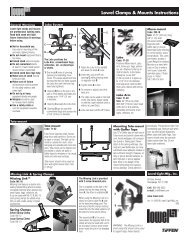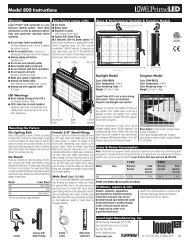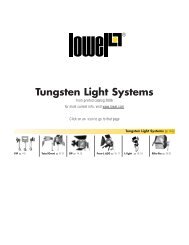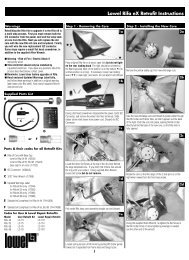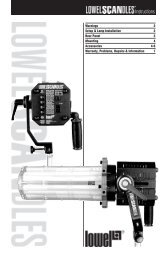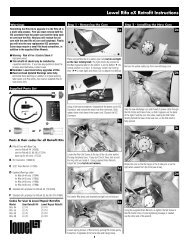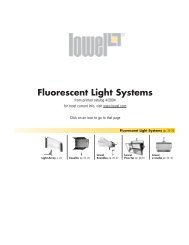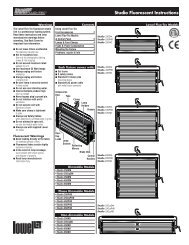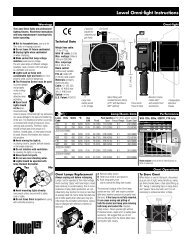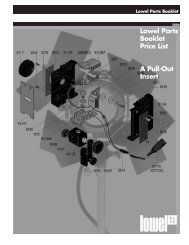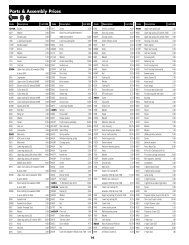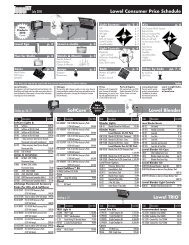Price List - Lowel
Price List - Lowel
Price List - Lowel
You also want an ePaper? Increase the reach of your titles
YUMPU automatically turns print PDFs into web optimized ePapers that Google loves.
Online ResourcesLearn to Light BetterLighting for Green Screen (excerpt)In this example we tried to match the light direction andquality of the scene that is matted into the background.The sun's direction is indicated by the shadows on thewindow frames. There is no hair light. In this case it wouldhave been an unnatural second source. Notice, the biggestlight is not always the key light.The green screen background is being evenly lit bytwo Omni-lights with 300watt bulbs and diffused withSpecial / White Tota-brellas. The barndoors were left on toblock the direct light from the front of the light flaring thecamera lens.DP Light with a Special / White DP Brella and a 1000 Wattbulb is providing the fill to open up the shadows on themodel. Again the barndoors were used to flag the front ofthe light. A combination of distance and adjusting thebarndoors allowed us to get the fill level where we wanted.BeforeThe overhead office lights provide enough light to make an exposurebut you can see they have a very unflattering effect on the subject. Her eyes are nearly lostin shadows, her forehead is the brightest part of her face, and there is a long shadow underher nose. We turned them all off.The Omni-light from the kit was fitted with the gel frame and frost gel.With the subject facing the interviewer's position, placement and height of the light wereadjusted until the subject's nose shadow blended along the line below her cheek to the endof her mouth. A stand with the Tota-light and umbrella was placed just to the left of thecamera position, a little higher than her head. This caused the shadows from the light to falllower, behind the subject; avoiding a second set of shadows from being visible behind her.We adjusted the light's distance to the subject until we saw the amount of fill, or lighteningof shadows, we wanted. The Pro-light was placed as far behind her as possible withoutbeing visible in the frame. It added a shine to her hair that appears to be coming from thelamp in the background. If we placed this Back or Hair light too high there would be a hardshadow on the desktop in front of her, and the tip of her nose would have a distractingbright spot. The barn doors on this light werepinched together to only allow lighton her hair.In the final image, overall, the lightinghas a smoother appearance. The hair lightputs a more subtle shine on her hair. Theimage has less contrast but there is stillenough difference between the Key and Filllights to show the contours of her face.Lighting for Interviews (excerpt)Lit with the DV Creator 1 KitAfterCameraLighting Glass (excerpt)Placing an average wine glass on a table with a darkbackround, and taking a close look at it, you will immediatelyfind that its curved reflective surface will tend to show theentire room. Every window, table lamp, or any other brightobject will be visible. You need to control the lighting of theroom around the glass, to affect what is seen in the glass.In many cases the glass object you light will beclear, so it is often a combination of lighting what is behindthe glass (and seen through it), as well as what is seenreflected in the glass. Properly placed, reflections can do a lotto help define the shape of the object. Paying attention tothese 2 aspects can bring creative possibilities that, while simple in theory, can bechallenging to actually execute. The narrow white highlights on the sides of the glass arereflections from the large white panels placed on each side of the dark centered background.They are lit by a 250W focusable Pro-light. Since any light shining in front of the glass willbe reflected in it, we need to block the beam of the Pro-light from hitting the glass, hencethe Tota-flag attached to the light stand. Lighting glassrequires attention to detail & can be painstaking work. Theback of the setup is actually a full width white cardboard with asmaller black cloth draped in the center.By changing the area size of the white panels,we can change the width of the reflections in the glass. Thisgives us more creative flexibility, by narrowing the width of thecenter black cloth, the white sides get larger and have a directeffect on what shows up in the glass. Using white cardreflection to define the shape of a glass object is called"White Line Lighting".79



